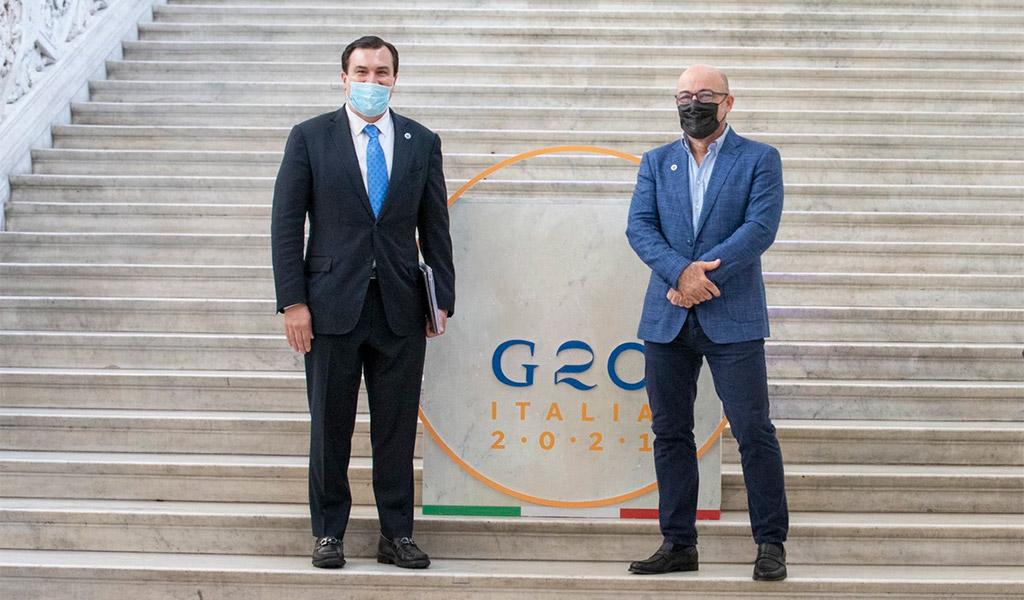Three Research Priorities As The World Rethinks Global Energy Governance
In the second in a series of articles on the IEF's research program, Dr Leila R. Benali, Chief Economist at the International Energy Forum, lays out the agenda for the forum's governance-related work.
By Dr Leila R. Benali
Reflecting on Naples, where the IEF participated in the first-ever joint G20 Energy-Climate Ministerial Meeting, I was struck by a simple yet shocking fact which illustrates why global multilateral governance frameworks are being tested like never before: it took 300,000 years for humanity to reach a population of three billion in 1960, and only 40 years for it to double.

Even before the COVID-19 pandemic, global energy governance was already being reshaped, at times questioned, by shifting superpower dynamics and a rapidly growing and changing world. But the pandemic has exposed unprecedented challenges to global consensus-building, particularly in the area of public health, security, but also climate, energy and other issues that require a truly global response. On the plane back from Italy, socially-distanced in a half-full Airbus A321, armed with vaccination certificates and PCR tests, one fellow delegate described the meeting as "a happy outcome". His conclusion could not have contrasted more with the verdict of the media. The Financial Times headlined: "Fraught G20 meeting on new climate targets highlights divisions."
The Group of 20 is, by definition, a diverse group of nations with different national circumstances. In their final communiqué, energy and climate ministers highlighted the "importance of multilateralism and international cooperation and the provision of technical and financial support to developing countries."
Ministers were able to agree 58 actions needed to implement the goals of the Paris Agreement, but conceded that after "prolonged and tireless discussion" consensus was not achieved on two key issues, namely the need to set a date to phase out unabated coal power plants and fossil fuel subsidies.
While much ink has been spilled and financial resources spent on the road to net-zero by 2050 and ESG ratings, three key areas remain overlooked in relation to global energy governance as the multi-trillion dollar industry responds to a fast-changing policy and financial environment with widespread industry restructuring.
1. Clean energy R&D cannot rely on traditional funding models alone
Global public and private investments in clean energy research and development (R&D) are unsurprisingly on the rise. However, the commerciality of future technologies will depend on bridging deep differences between regions and types of funding. On an aggregate level, China, the US, Japan, France and Germany are expected to continue to lead and the key question is what type of technologies and funding will enable these R&D efforts to become commercial. The US public investment in energy research, development and deployment (RD&D) of $8 billion is equivalent to the total commitment of major international oil companies (IOCs) in annual low-carbon investments (major IOCs committed $6 billion last year and plan on $15 billion in 2025). This is nowhere near enough to meet expectations of the Paris Agreement, which requires a leap in technology. The scaling up will require new funding models beyond the traditional government and private sector sources, to include everything from venture capital to multilateral lending, institutional and retail investment. For example, in nuclear energy, while a large share of government funding is absorbed by research into fission, there is also a big opportunity to develop exportable small modular reactors, while funding for this technology is still limited. Beyond venture capital, industry funding and traditional acquisitions, some emerging regions are building the required maturity of their financial markets. MENA is slowly witnessing an increasing number of SPAC deals and investor interest in the energy-related and mobility startup ecosystem.
To enhance global understanding of the type of technologies and funding models at play, given the differences between regions in terms of financial maturity, clean energy ambitions and post-COVID recovery requirements, the IEF will embark on a clean energy R&D research initiative, to support policymakers in creating frameworks for greater and more diversified financing.
2. Energy pricing transparency is critical to de-risking policy and encouraging investment and funding
Even in fully liberalized markets, domestic energy pricing, taxation and regulation is a sovereign matter taking into account social and economic considerations such as affordability and competitiveness. But there has been a lack of analysis into the implications of energy pricing preferences on inter-technology and inter-fuel competition within national boundaries. For example, when electricity price formation is determined ex-ante, this leaves room for technology and market risks to be under-estimated, and for possible solutions to be overlooked. Across North Africa, Middle East and Latin America, there are examples of costly concentrated solar power projects preventing the penetration of gas-based or nuclear power generation, for example.
Transparent and predictable energy pricing and taxation remains a critical element of stable energy investments regardless of the economic policy orientation. Since an increasing number of countries have introduced some form of carbon taxation or trading, the valuation of carbon content makes transparency on the different cost elements in energy prices even more urgent.
Building on the oil and gas data transparency efforts of the Joint Organizations Data Initiative (JODI), the IEF intends to contribute to the standardization of carbon accounting in energy trade and will complement the exercise by dissecting the evolving elements of energy pricing on a global level.
3. Future-proofing existing infrastructure will include blending new fuels, but scaling up will require new business models
Decarbonizing transportation and hard-to-abate industries will require blending existing fuels with low carbon alternatives. Italian grid operator Snam recently tested a blend of natural gas with 30 percent hydrogen at a steel plant. To play a greater role in the energy system, hydrogen's production cost must fall dramatically. The increased demand for hydrogen created by this blending strategy would increase demand for renewable energy, reducing production costs for one key component of green hydrogen. Aside from economies of scale, reducing hydrogen's production costs will require scaling up the size of electrolyser plants, assembly lines and capacities. Electrolysis capacity targets add up to 80-100GW by 2030, with 40GW by the EU and 25GW by Chile alone. Today, the global installed capacity dedicated to hydrogen production does not exceed 200MW. Like other fuels and energy carriers, new business models and contractual terms will need to accompany this scaling-up.
The IEF will analyze the required business models and contractual supply frameworks for emerging energy carriers and fuels to scale up.
Dr Leila R. Benali is Chief Economist at the International Energy Forum.






